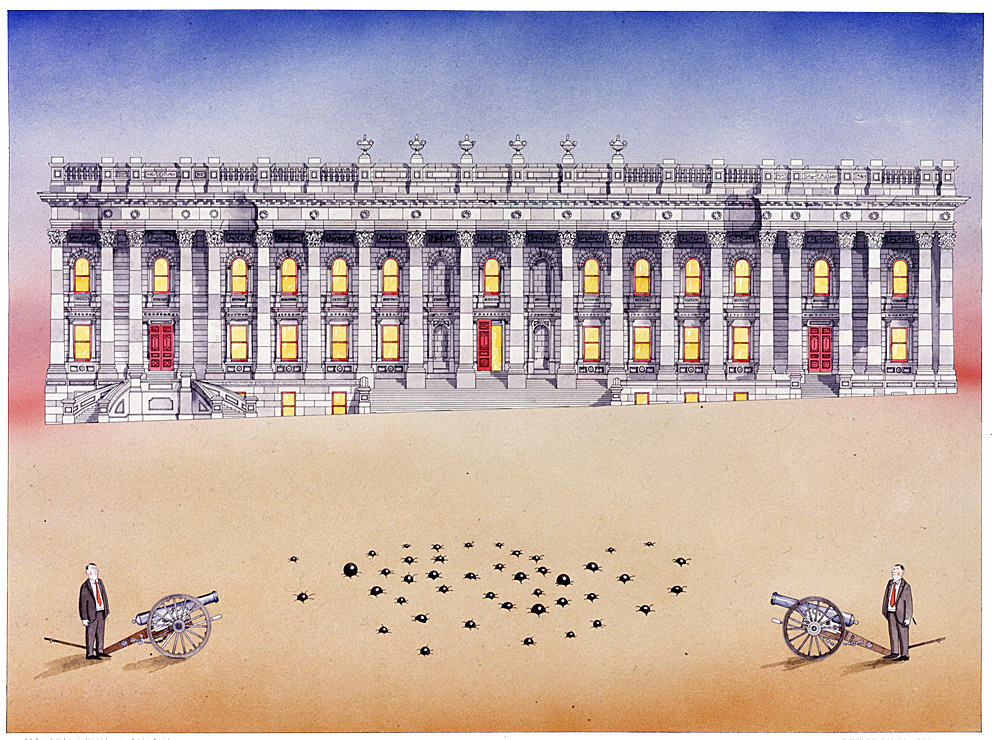
Parliament House - Adelaide
Parliament House in Adelaide, South Australia, stands as a testament to the rich history and democratic traditions of the region. This iconic building, perched majestically on the corner of North Terrace and King William Road, has served as the seat of the South Australian Parliament since its completion in 1939. With its distinctive architectural style and historical significance, Parliament House is more than just a government building; it is a symbol of the state's commitment to democracy and good governance.
Designed by the renowned architect Edward John Woods, Parliament House boasts an exquisite blend of architectural styles, primarily Georgian and stripped Classical. Its stately façade, characterized by grand colonnades and a prominent central dome, exudes an aura of authority and permanence. The use of local materials, such as Murray Bridge limestone and Kapunda marble, adds to its distinctive South Australian character. The building's remarkable architecture makes it a cherished heritage site in Adelaide.
Inside, Parliament House is equally impressive. The Chambers of the House of Assembly and the Legislative Council are where the heart of democracy beats. The House of Assembly, the lower house, is where elected members represent their constituents and debate matters of public concern. The Legislative Council, the upper house, plays a vital role in scrutinizing and revising legislation. The grandiose interior of these chambers features fine woodwork, exquisite stained glass windows, and a gallery for public viewing, offering a unique opportunity for South Australians to witness their democracy in action.
Parliament House also houses a museum and a public café, allowing visitors to explore the history and significance of the South Australian Parliament. The museum features a collection of historical artifacts, documents, and exhibits that provide insights into the state's political evolution, including its progressive role in women's suffrage and social reforms. The presence of these educational and historical spaces underscores the commitment of the South Australian government to transparency and civic engagement.
In addition to its historical and architectural significance, Parliament House plays a vital role in the day-to-day workings of South Australia's government. It serves as a hub for lawmakers to discuss, debate, and legislate on issues that affect the lives of South Australians. This building is where policies are crafted, laws are enacted, and the principles of democracy are upheld.
In conclusion, Parliament House in Adelaide is not merely a government building; it is a symbol of South Australia's democratic traditions and commitment to open, transparent governance. Its architectural beauty, historical significance, and pivotal role in the state's political landscape make it a cherished landmark. The building's inviting and educational spaces ensure that South Australians have the opportunity to engage with their government and understand the history and principles that underpin it. Parliament House, with its blend of history, heritage, and democracy, stands as a source of pride for the people of South Australia and a testament to the enduring strength of their democratic institutions.
The external façade of Parliament House is characterized by neoclassical elements, such as imposing columns, a grand portico, and a central dome. The use of these classical features was a deliberate choice to convey a sense of stability, timelessness, and authority, all of which are essential qualities for a government building. The large Corinthian columns that flank the entrance create an aura of strength and power, while the dome, a common feature in classical architecture, adds a sense of grandiosity. The dome is particularly notable, with its elegant proportions and the use of Kapunda marble, which gives it a distinctive white hue.
The choice of locally sourced materials, such as Murray Bridge limestone for the exterior and Kapunda marble for the interior, further enhances the building's connection to the South Australian landscape. These materials not only contribute to the architectural beauty but also speak to a commitment to the region and its resources.
The interior of Parliament House continues to impress with its attention to detail and the quality of craftsmanship. The chambers of the House of Assembly and the Legislative Council are adorned with intricate woodwork, including elegant paneling and finely carved furniture. Stained glass windows, featuring motifs and symbols of South Australia, allow natural light to filter into the chambers, creating a warm and welcoming atmosphere. The use of rich timbers and decorative plasterwork throughout the building adds to its opulence.
The attention to architectural detail extends to the design of the grand staircases, hallways, and public galleries. These spaces are adorned with historical portraits and artworks, creating a sense of continuity and tradition. Visitors can explore these areas to appreciate not only the architectural finesse but also the historical narrative woven into the building's design.
In addition to the neoclassical elements, Parliament House also incorporates some Georgian design influences, which are evident in the symmetrical layout and the use of proportions to create a harmonious and balanced structure.
Parliament House's architecture stands as a tribute to the ideals of democracy and the enduring values of government. Its classical and neoclassical features evoke a sense of tradition, stability, and authority, while its commitment to using local materials reinforces its connection to South Australia. The building's timeless design continues to captivate visitors and serves as a symbol of the state's democratic principles, making it a true architectural and historical treasure.